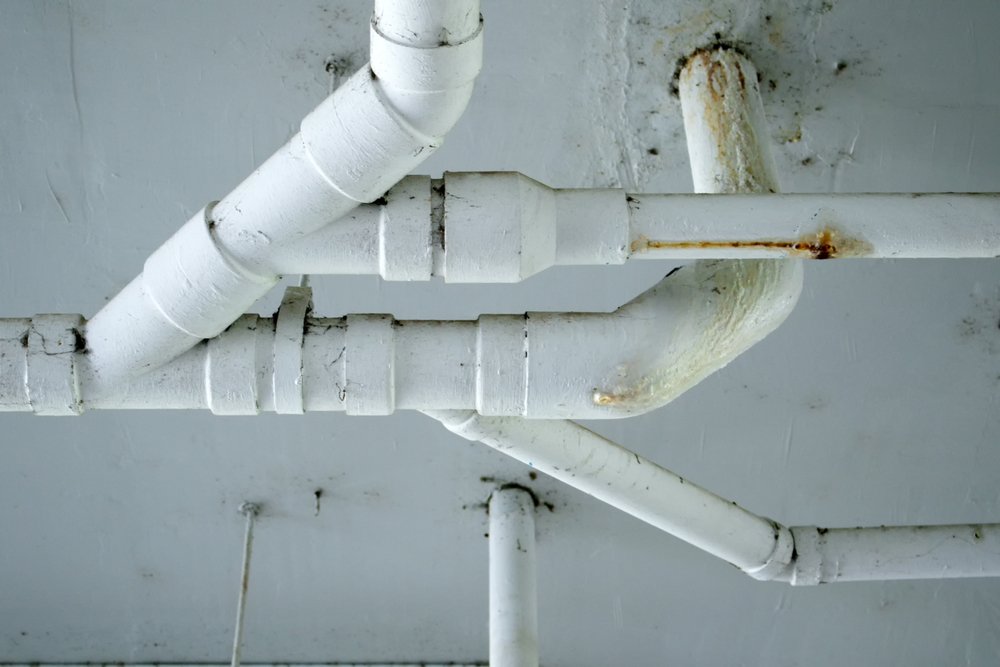You’re enjoying a quiet evening at home when you notice a wet spot on the living room wall. You think it’s just a minor issue, maybe a small spill, but over the next few days, the spot grows, and a musty smell starts to fill the air. That’s when it hits you—it’s not just a spill; there’s a leak inside your wall.
You call a plumber, who inspects your pipes and warns you that your old plumbing is starting to fail. Over the years, the pipes have corroded, and now they’re beginning to leak, causing damage to your walls and floors. The plumber indicates that these signs—damp spots, strange smells, and even fluctuating water pressure—are all indications that it’s time to replace your old pipes. Ignoring these warning signs could lead to more serious problems, like burst pipes or major water damage.
You decide to take action before things get worse. The plumber replaces your old pipes with new, more durable ones, bringing your home’s plumbing system back to top shape. The damp spot dries up, the musty smell disappears, and your water pressure is better than ever.
In this blog, we’ll explore several key indications that it’s time to replace your old plumbing, helping you avoid costly repairs and keep your home safe.
What Are the Signs of Corroded Pipes?
Corrosion is one of the more evident indications that it is time to repair your plumbing pipes. Pipes composed of materials like galvanized steel can corrode over time as a result of the water-metallic reaction. This corrosion weakens the pipes, which causes leaks, discolored water, and reduced water pressure.
1. Discolored Water
If you notice brown or rusty water coming from your taps, it’s a strong sign that your pipes are corroding from the inside. This discoloration happens when the metal pipes deteriorate and release rust particles into the water. Rusty water is not only unappealing but can also stain your fixtures and clothing.
2. Frequent Leaks
Frequent leaks are another sign of corroded pipes. As pipes corrode, they become brittle and prone to cracking, which leads to leaks. These leaks can cause water damage to your walls, floors, and ceilings, resulting in costly repairs.
“A small leak today can turn into a big problem tomorrow. Don’t ignore the signs of corroded pipes.”
3. Reduced Water Pressure
Corroded pipes often have reduced internal diameters due to the buildup of rust and corrosion, leading to reduced water pressure. If you’ve noticed a decrease in water pressure, especially in multiple fixtures, your pipes may be the culprit.
How Does Pipe Material Affect Longevity?
The material your pipes are made from plays a significant role in how long they last. Different materials have different lifespans, and understanding these can help you determine when it’s time for a replacement.
PVC Pipes
PVC pipes are commonly used in modern plumbing systems and have a long lifespan of up to 100 years. However, they can become brittle and crack if exposed to UV light or extreme temperatures. Replacing PVC pipes may be necessary if they show signs of aging or damage.
Galvanized Steel
Before the 1960s, residences were usually built with galvanized steel pipes. But they have an average lifespan of between 20 to 50 years. Over time, these pipes corrode, leading to leaks and water quality issues. If your home has galvanized steel pipes, it may be time to consider a replacement.
Copper Pipes
Copper pipes are durable and resistant to corrosion, with a lifespan of 50 to 70 years. However, they can develop pinhole leaks over time, especially in areas with highly acidic water. Regular inspections are key to determining if your copper pipes need replacing.
When Do You Need to Replace Your Pipes Due to Frequent Clogs?
Frequent clogs can be more than just an inconvenience; they may indicate that your pipes are deteriorating from the inside. Pipes that are old, corroded, or damaged can develop rough interior surfaces that catch debris and lead to clogs.
Sign 1: Slow Drains
If your sinks, toilets, or tubs are draining slowly, even after using a plunger or drain cleaner, it could be a sign that your pipes are clogged or deteriorating. Slow drains often indicate that the interior of the pipes is rough, allowing debris to build up and cause blockages.
Sign 2: Persistent Clogs
Persistent clogs, particularly in multiple fixtures, can signal a deeper issue with your plumbing pipes. If clogs continue to occur even after professional cleaning, it may be time to replace your pipes to prevent further damage.
Sign 3: Gurgling Sounds
Gurgling sounds coming from your drains can indicate that air is trapped in the pipes due to clogs or damage. This could be a sign that your pipes are not functioning properly and may need to be replaced.
Which Is the Best Option to Replace Your Old Pipes?
When it’s time to replace your old plumbing pipes, choosing the right material is crucial. Different types of pipes offer varying levels of durability, flexibility, and resistance to corrosion.
1. UPVC Pipes
Modern plumbing systems typically use UPVC pipes and fittings. They are corrosion-resistant, strong, and lightweight. UPVC pipes are also affordable and easy to install, which makes them a great option for replacing old pipes.
2. Schedule 40 PVC Pipes
The Schedule 40 pipes are made from PVC and are designed to withstand high water pressure. They are commonly used in residential and commercial plumbing systems and offer excellent durability and resistance to corrosion.
3. PPRC Pipes
PPRC pipes and fittings are known for their high resistance to heat and pressure, which makes them ideal for hot and cold water systems. These pipes are durable and long-lasting, with a lifespan of up to 50 years.
4. HDPE Pipes
HDPE pipes and fittings are flexible, durable, and resistant to corrosion. They are commonly used in underground and outdoor applications due to their ability to withstand harsh conditions. HDPE pipes have a long lifespan and are an excellent choice for replacing old pipes.
Why Is It Important to Replace Old Pipes in Renovations?
When you’re renovating your home, it’s the perfect time to consider replacing old plumbing pipes. Renovations often expose old pipes, which makes it easier and more cost-effective to replace them.
- Access to Pipes: During renovations, walls, floors, and ceilings may be opened up, giving you access to old pipes. Replacing pipes at this time can save you money on future repairs and prevent potential water damage to your newly renovated space.
- Upgrading Materials: Renovations provide an opportunity to upgrade with the latest plumbing materials like UPVC, PPRC, HDPE, and Schedule 40 pipes. These materials are more durable, corrosion resistant, and have a longer lifetime than previous materials such as galvanized steel or cast iron.
- Increased Property Value: Upgrading your plumbing system during renovations can increase the value of your property. Potential buyers are likely to appreciate a home with a modern and reliable plumbing system, making it a worthwhile investment.
How Do Leaks indicate that it’s Time to Replace Your Pipes?
Leaks are one of the most obvious signs that it’s time to replace your old plumbing pipes. While a small leak may seem like a minor issue, it can lead to significant water damage and costly repairs if left unaddressed.
Indication 1: Visible Water Damage
If you notice water stains on your walls, ceilings, or floors, it could be a sign of a hidden leak in your plumbing system. Visible water damage indicates that your pipes may be deteriorating and need to be replaced.
“If not fixed immediately, leaks can do more than just waste water—they can seriously damage your property.”
Indication 2: Mold and Mildew Growth
Leaks create a damp atmosphere which supports the growth of mold and mildew. If you notice mold or mildew in your home, especially in areas where it shouldn’t be, it may be a sign that your pipes are leaking and need to be replaced.
Indication 3: Increased Water Bills
A sudden increase in your water bill could indicate that you have a hidden leak in your plumbing system. Even small leaks can waste a significant amount of water over time, leading to higher bills and the need for pipe replacement.
Indication 4: Low Water Pressure
Low water pressure can be caused by leaks or blockages in your plumbing system. If you notice a sudden drop in water pressure, it’s a good idea to have your pipes inspected and consider replacing them if necessary.
“Low water pressure can be a sign of bigger problems lurking within your plumbing system.”
Indication 5: Strange Noises
If you hear hissing, dripping, or other unusual noises coming from your pipes, it could be a sign of a leak. Strange noises indicate that water is escaping from your pipes and could be causing damage to your home.
Adamjee DuraBuilt: Your Trusted Partner for Pipe Replacement
When it comes to replacing old plumbing pipes, Adamjee DuraBuilt is your reliable partner. As a leading plastic pipe manufacturer in Pakistan, we provide an extensive range of high-quality piping solutions, like as PVC Pipes, UPVC pipes, PPRC pipes, HDPE pipes, and Schedule 40 pipes. Our products are ideal for residential, commercial, and industrial applications because they are made to the highest standards of performance, durability, and resistance to corrosion.
Why Choose Adamjee Pipes?
- High-Quality Materials: We use only the best materials to ensure our pipes are durable and long-lasting.
- Wide Range of Products: Our extensive product line includes pipes and fittings for all your plumbing needs.
- Expertise and Experience: With years of experience in this industry, we understand our customers’ specific needs.
- Customer Satisfaction: We are dedicated to providing outstanding support and customer service.
- Innovative Solutions: We continuously innovate to provide the most advanced and reliable piping solutions.
Final Observations
Replacing old plumbing pipes is an essential step in maintaining a safe and functional plumbing system. Whether you’re dealing with corroded pipes, frequent clogs, or leaks, recognizing the signs early can save you time, money, and hassle in the long run. When choosing the right materials and working with a reputable supplier like Adamjee DuraBuilt, you can ensure that your plumbing system is reliable, durable, and built to last.
When it comes to your home’s plumbing, don’t wait until it’s too late. Keep an eye out for the signs mentioned in this blog and take action when necessary. A proactive approach to pipe replacement will help you avoid costly repairs and ensure the longevity of your plumbing system.
“When the pipes start to break down, it’s time to act—don’t wait for something terrible to happen.”
Discover more interesting blogs on our site



